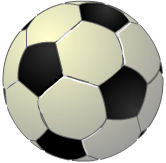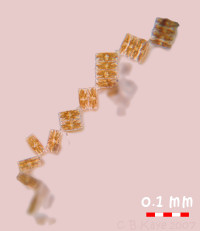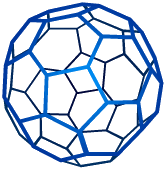A journey to the nano-world
Nanotechnology is concerned with objects between 1 and 100nm in size. Our journey to visit this nano-world starts with a picture of an everyday object, but when we reach the nano-scale, objects are too small to be seen even with the most powerful optical microscopes…

Football (soccer) is a game played all around the world. The ball drawn here has been tiled with regular hexagonal and pentagonal leather patches. It turns out that to tile a ball in this way, with none of the black pentagons touching, requires exactly 12 leather pentagons and 20 leather hexagons.
To get down to the nano-scale quickly we shall have to travel through space logarithmically – each division of the length scale in the movie above therefore indicates a change in size by a factor of ten. To give an idea of relative scale, a one Euro coin (2.3cm) is approximately one tenth the diameter of a football.
Small multicellular organisms, such as pet fleas, are about 1mm in size (one thousandth of a metre, or 10-3m). While these insects are visible, it is difficult to make out any detail without the help of a hand lens or microscope. It is thought that the smallest adult multicellular organisms are about 0.2mm in size.

Many single-celled organisms are about one tenth of a millimetre (10-4m) in size. A chain of single-celled marine diatoms is shown in the photomicrograph left. Diatoms are interesting to nanotechnologists because they use proteins to sculpt their shells into intricate patterns down to the molecular scale. Nanotechnologists believe that we can learn from organisms like the diatoms how to engineer new nano-scale devices.
Red blood corpuscles are both the smallest and the simplest cells in our bodies. They have to be small because they need to travel through intercellular spaces to deliver oxygen to tissues. Corpuscles are less than one hundredth of a millimetre (10-5m) in diameter, and we need a high-powered light microscope to examine them.
Visible light consists of electromagnetic radiation with a range of wavelengths between 0.4 × 10-6m (violet) and 0.7 × 10-6m (red). Objects much smaller than one millionth of a metre (10-6 m or 1µm) in diameter therefore cannot be seen even with the most high-powered optical microscope. Studying objects smaller than this requires specialist equipment, some of which is described in our technology timeline.
The smallest ‘living’ things are viruses, simple packages of DNA or RNA that rely on the cellular machinery of host organisms to reproduce. These can be as small as one tenth of a micron (10-7m or 100nm) in diameter, and are the only organisms that live on the borders of the nano-world.
Many protein complexes essential to life have diameters of approximately 10-8m (10nm). These proteins form tiny motors, pumps and chemical factories, they are the building blocks of life, and their study is one of the challenges of nano-scale science.
If proteins are life’s factories, DNA is life’s foreman. A single strand of DNA has a diameter of about 2nm, but the strand may be several millimetres long!

Carbon atoms can be bonded together to form stable hexagonal and pentagonal rings; these can be linked together in a pattern identical to that of the football’s leather patches. This creates a sphere 0.7nm (0.7 × 10-9m) in diameter, which contains 60 carbon atoms, and is called carbon-60 (C60) orBuckminsterfullerene.
In our journey from a football to a C60 molecule, we can see that some things, like the rules of geometry, are unchanged. We need the same numbers of hexagons and pentagons to tile a sphere irrespective of how big the sphere is! A lot of other things are different in the nano-world, however, and it is these differences that help make the nano-world an interesting challenge to scientists and engineers.
To find out why things behave differently at the nano-scale: